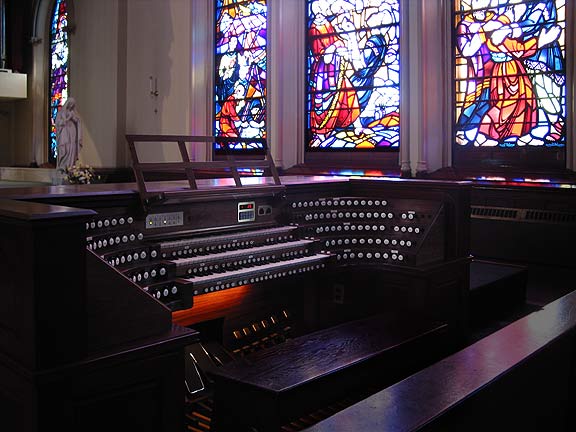OPUS 38
September 2000
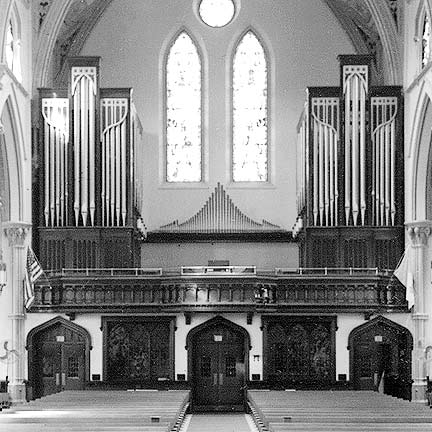
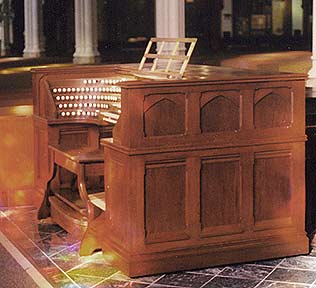
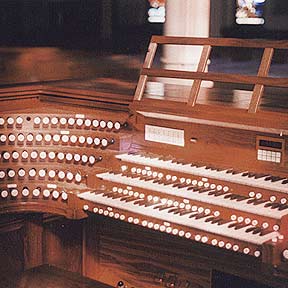
GRAND
ORGUE
|
(Manual I) | |
16
16 8 8 8 8 8 4 4 2 2/3 2 1 3/5 16 8 8 4 8 |
Montre Flūte Conique Montre Diapason Salicionel Flūte Harmonique Bourdon Prestant Flūte ą Cheminée Quinte (J) Doublette (J) Tierce (J) Fourniture V Cornet (tc) *V Trompette Bombarde (Pedale) Trompette Clairon Trompette en Chamade (C) G. O. Octaves Graves G. O. Muet Pedale to G. O. * PREPARED J Johnson pipes C Casavant pipes |
|
POSITIF
EXPRESSIF
|
(Manual II) | |
8
8 8 8 8 4 4 2 2/3 2 1 3/5 8 8 8 |
Montre
* Salicionel (G.O.) Flūte Double (C) Flūte Conique (C) Cor de Chamois (C) Prestant Flūte Ouverte Nasard Quarte de Nasard Tierce Petit Plein Jeu IV Trompette Clarinette (J) Trompette en Chamade Tremblant Positif Octaves Graves Positif Muet |
|
RECIT
|
(Manual III) | |
16
8 8 8 8 4 4 4 2 2/3 2 1 3/5 1 1/3 16 8 8 8 8 |
Bourdon(C) Diapason Bourdon Viole de Gambe (J) Voix Céleste (J) Prestant Violina (J) Flūte ą Fuseau Nasard* Octavin Harmonique (J) Tierce* Larigot * Plein Jeu V Cymbale IV * Basson (C + J) Trompette Hautbois Voix Humaine (Hall) Trompette en Chamade Tremblant Recit Octaves Graves Recit Muet Recit Aigu |
|
PEDALE
|
||
32
16 16 16 16 16 8 8 8 8 4 4 32 16 16 16 8 8 8 4 4 8 |
Soubasse Contrebasse (J) Montre (G.O.) Soubasse (C) Bourdon Doux (Recit) Flūte Conique (G.O.) Principal (J) Bourdon (C) Bourdon Doux Flūte Conique (G.O.) Octave (C + J) Flūte Ouverte Fourniture V-VI Grande Cornet V Contre Bombarde Bombarde Trompette (G.O.) Basson (Recit) Bombarde Trompette (G.O.) Basson (Recit) Clairon (G.O.) Chalumeau (Recit) Trompette en Chamade Pedale Muet |
|
ORGUE
DE CHOER
GRAND ORGUE |
||
8
8 8 4 2 8 |
Montre
(new) Bourdon (W) Flūte Ouverte tc (W) Prestant (W) Doublette (W) Plein Jeu (Recit) IV Trompette * Grand Orgue Muet |
|
RECIT
|
||
8
8 8 8 4 4 2 8 |
Principal
(W) Flūte ą Cheminee (W) Salicional (J) Voix Céleste (J) Prestant (W) Flūte ą Fuseau (W) Flūte ą bec (W) Plein Jeu (new) IV Hautbois (J) Recit Muet |
|
PEDALE
|
||
16
16 8 8 4 4 8 8 |
Montre
* (W)
denotes Orgue de Choer pipes originally from Wicks |
|
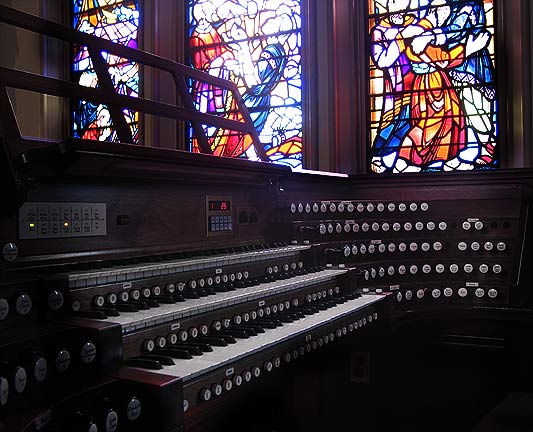
Saint Paul’s Cathedral in Worcester, Massachusetts, is a grand, American Gothic structure, seating 1,200 people. The building has superb acoustics, with approximately six seconds of reverberation and a even response throughout the frequency spectrum. In 1997, John Sittard, the Director of Music at St. Paul's at that time, was charged with the task of overseeing the renovation or replacement of the Cathedral's two instruments.
The Gallery instrument of 49 ranks was a 1952 Casavant rebuild of an earlier Johnson organ. Casavant provided all new mechanism while retaining most of the Johnson pipework. Some of the Johnson pipework was rescaled and additional ranks added in keeping with the tonal thinking of the day. In general, the existing foundation stops were rescaled to be narrower while mixture scales were increased. A number of tapered ranks were added both as foundation stops and as mutations. A new Pedal 16' reed and Chamade were also added. A low cost organ case, reminiscent of speaker enclosures, was provided to hide the organ. While adequate for accompanimental functions, the organ lacked the ability to lead a large congregation as well as the resources necessary for the performance of organ literature.
During the 1960's, the Cathedral underwent a number of changes consistent with the reforms of Vatican II. The choir was brought to the front of the church and a new Wicks instrument of 13 ranks was installed in the right front corner of the nave near the choir. A new Wicks console was provided which was capable of controlling both instruments. The Wicks instrument, voiced gently in a typical mid 60s neo-baroque style, was suitable for accompanying a small choir.
In the ensuing years, both instruments were allowed to deteriorate. Forty-five years of city air had taken its toll on the Casavant’s organ leathers and the Wicks console and relays were failing.
At the outset of the project, a number of goals were articulated:
- The overall character of the instrument should be inspired by the organs of Cavaille-Coll, utilizing, so much as possible, existing tonal resources without compromising the tonal integrity of the finished instrument. In addition to an overall French Romantic character, the instrument should have sufficient tonal resources to adequately render music from other periods as well as fulfilling liturgical and accompanimental roles.
- The instrument should have a wide dynamic range with lighter choruses suitable for small congregations, yet be capable of filling the room with sound when all 1,200 seats are filled.
- Two new consoles with matching control placement in the ‘Amphitheatre’ style capable
- A new Gallery casework front should be provided, appropriate to the architecture of the building.
- All existing mechanisms to be completely rebuilt or replaced with the finest materials to insure maximum longevity and trouble free operation. Ideally, slider and pallet windchests should be provided for the gallery manual divisions.
- Layout changes should be made to improve tuning stability and service access.
- The chancel organ should be expanded and revoiced to provide suitable leadership for congregational singing as well as expanded accompanimental abilities.
A brief description of the work follows.
In the Gallery organ, the Casavant wind system was retained, with all wind regulators being releathered and restored as appropriate. The Swell and Choir pitman chests were releathered with some slight modification for the revised specifications. New chests were provided for the Plein Jeu stops in both the Swell and Choir. A new slider and pallet chest was provided for the Great. New electro-pneumatic wind chests were also provided for the remaining Great and Pedal unit stops.
The Wicks direct electric action in the chancel organ was in good condition and was used with minor modification and new relays. However, new wind regulators were fitted to the organ to eliminate a severe wind sag condition. A single new chest for the Plein Jeu was added to the Swell. Existing pipework in the chancel organ was rearranged, rescaled and completely revoiced, revealing a beautiful singing quality that was not evident in the original voicing. A new Principal 8' of proper scale was added to the Great chorus, along with a new Plein Jeu IV, located in the Swell but conceived as part of the Great chorus. A pair of medium scale Johnson strings and the Johnson Oboe was moved from the Gallery to the chancel.
The majority of pipework in the Gallery organ is either new or has been rebuilt from existing ranks. A few ranks were revoiced from the best examples of the pre-existing pipework. The specifications indicate the revoiced Casavant and Johnson pipework. New consoles and organ casework were provided as per the design goals.
The
resulting instrument combines the best work of Johnson, Casavant
and Wicks in conjunction with our own work to create what is essentially
a new instrument, ready for the task of making magnificent music
through the twenty-first century.
